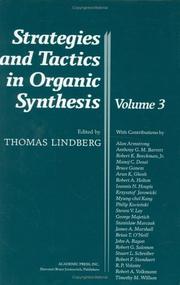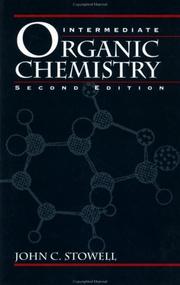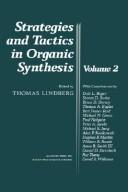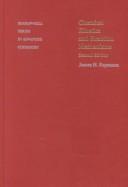| Listing 1 - 10 of 10 |
Sort by
|
Article
Abstract | Keywords | Export | Availability | Bookmark
 Loading...
Loading...Choose an application
- Reference Manager
- EndNote
- RefWorks (Direct export to RefWorks)
Book
ISBN: 089573494X 3527264671 Year: 1987 Publisher: Weinheim : VCH Publishers,
Abstract | Keywords | Export | Availability | Bookmark
 Loading...
Loading...Choose an application
- Reference Manager
- EndNote
- RefWorks (Direct export to RefWorks)
Oxidation. --- Addition reaction --- Alkylation --- Catalysis --- Reduction (chemistry) --- Transition state structure --- Addition reaction --- Alkylation --- Catalysis --- Reduction (chemistry) --- Transition state structure

ISBN: 9780080924304 0080924301 1299193021 9781299193024 9780080924298 0080924298 9780123865397 0123865395 0124502822 9780124502826 0080993621 9780080993621 0081007566 9780081007563 0128117907 9780128117903 9780124502833 0124502830 9780123865403 0123865409 0124502806 9780124502802 0124502814 9780124502819 0124502865 9780124502864 012450289X 9780124502895 0123739039 9780123739032 0124502873 9780124502871 9780080993621 9780081007563 9780128117903 9780081000236 0081000235 9780124171855 0124171850 012450275X 9780124502758 9780128148051 0128148055 0124502849 9780124502840 0124502881 9780124502888 Year: 1984 Publisher: Orlando Academic Press
Abstract | Keywords | Export | Availability | Bookmark
 Loading...
Loading...Choose an application
- Reference Manager
- EndNote
- RefWorks (Direct export to RefWorks)
Strategies and Tactics in Organic Synthesis
Organic compounds --- Synthesis. --- Alkaloids --- Cyclophanes --- Dodecahedrane --- Gibberellins --- Macrolides --- Prostaglandins --- Terpenes --- Transition state structure,pericyclic

ISBN: 0471574562 9780471574569 Year: 1994 Publisher: New York, NY ; Chichester : John Wiley,
Abstract | Keywords | Export | Availability | Bookmark
 Loading...
Loading...Choose an application
- Reference Manager
- EndNote
- RefWorks (Direct export to RefWorks)
Chemistry, Organic --- NOMENCLATURE --- INFORMATION SCIENCE --- STEREOCHEMISTRY --- FUNCTIONAL GROUPS --- BOND --- REACTION MECHANISM --- TRANSITION STATE STRUCTURE,PERICYCLIC --- NUCLEAR MAGNETIC RESONANCE --- CARBON-CARBON
Book
ISBN: 3540586717 3540586725 0387586717 0387586725 3540490396 354049040X 9783540586715 9783540586722 Year: 1995 Volume: 173-174 Publisher: Berlin : Springer-Verlag,
Abstract | Keywords | Export | Availability | Bookmark
 Loading...
Loading...Choose an application
- Reference Manager
- EndNote
- RefWorks (Direct export to RefWorks)
Molecular structure --- Similarity (Physics) --- Structure moléculaire --- Structure moléculaire --- Electron configuration. --- Molecular topology --- Quantum mechanics --- Similarity theory --- SIMILARITY THEORY --- TRANSITION STATE STRUCTURE,PERICYCLIC --- MACROMOLECULAR COMPOUNDS --- ELECTRIC POTENTIAL --- GRAPH THEORY --- ORGANIC COMPOUNDS --- PROPERTIES

ISBN: 0124502806 0323152937 129936540X 9780124502802 9780124502819 0124502814 Year: 1984 Publisher: Orlando : Academic Press, Inc.,
Abstract | Keywords | Export | Availability | Bookmark
 Loading...
Loading...Choose an application
- Reference Manager
- EndNote
- RefWorks (Direct export to RefWorks)
Strategies and Tactics In Organic Synthesis
547.057 --- Organic compounds --- -Compounds, Organic --- Organic chemicals --- Carbon compounds --- 547.057 Organic chemistry--?.057 --- Organic chemistry--?.057 --- Synthesis --- Chemistry, Organic --- Chemistry, Synthetic organic --- Organic synthesis (Chemistry) --- Synthetic organic chemistry --- Synthesis. --- -Synthesis --- Organic compounds - Synthesis --- Alkaloids --- Cyclophanes --- Dodecahedrane --- Gibberellins --- Macrolides --- Prostaglandins --- Terpenes --- Transition state structure,pericyclic

ISBN: 0070202605 Year: 1995 Publisher: New York, NY : McGraw-Hill,
Abstract | Keywords | Export | Availability | Bookmark
 Loading...
Loading...Choose an application
- Reference Manager
- EndNote
- RefWorks (Direct export to RefWorks)
Chemical kinetics --- Chemical reaction, Conditions and laws of --- Cinétique chimique --- Réactions chimiques --- Mécanismes --- Reaction mechanisms (Chemistry) --- Inorganic reaction mechanisms --- Mechanisms, Inorganic reaction --- Mechanisms, Reaction (Chemistry) --- Reaction mechanisms, Inorganic --- Chemical reaction, Kinetics of --- Chemical reaction, Rate of --- Chemical reaction, Velocity of --- Chemical reaction rate --- Chemical reaction velocity --- Kinetics, Chemical --- Rate of chemical reaction --- Reaction rate (Chemistry) --- Velocity of chemical reaction --- Chemical affinity --- Reactivity (Chemistry) --- Cinétique chimique --- Réactions chimiques --- Mécanismes --- Reaction kinetics --- Reaction mechanism --- Reactive intermediates --- Transition state structure
Book
Year: 2021 Publisher: Basel, Switzerland MDPI - Multidisciplinary Digital Publishing Institute
Abstract | Keywords | Export | Availability | Bookmark
 Loading...
Loading...Choose an application
- Reference Manager
- EndNote
- RefWorks (Direct export to RefWorks)
Noncovalent interactions are the bridge between ideal gas abstraction and the real world. For a long time, they were covered by two terms: van der Waals interactions and hydrogen bonding. Both experimental and quantum chemical studies have contributed to our understanding of the nature of these interactions. In the last decade, great progress has been made in identifying, quantifying, and visualizing noncovalent interactions. New types of interactions have been classified—their energetic and spatial properties have been tabulated. In the past, most studies were limited to analyzing the single strongest interaction in the molecular system under consideration, which is responsible for the most important structural properties of the system. Despite this limitation, such an approach often results in satisfactory approximations of experimental data. However, this requires knowledge of the structure of the molecular system and the absence of other competing interactions. The current challenge is to go beyond this limitation. This Special Issue collects ideas on how to study the interplay of noncovalent interactions in complex molecular systems including the effects of cooperation and anti-cooperation, solvation, reaction field, steric hindrance, intermolecular dynamics, and other weak but numerous impacts on molecular conformation, chemical reactivity, and condensed matter structure.
Research & information: general --- solvent effect --- hydrogen bond --- NMR --- condensed matter --- polarizable continuum model --- reaction field --- external electric field --- proton transfer --- halogen bond --- phosphine oxide --- 31P NMR spectroscopy --- IR spectroscopy --- non-covalent interactions --- spectral correlations --- Reaction mechanism --- first-principle calculation --- Bader charge analysis --- activation energy --- transition state structure --- conventional and non-conventional H-bonds --- empirical Grimme corrections --- lattice energy of organic salts --- computation of low-frequency Raman spectra --- confinement --- solid-state NMR --- molecular dynamics --- interfaces and surfaces --- substituent effect --- aromaticity --- adenine --- Lewis acid–Lewis base interactions --- tetrel bond --- pnicogen bond --- triel bond --- electron charge shifts --- proton dynamics --- carboxyl group --- CPMD --- DFT --- IINS --- IR --- Raman --- crystal engineering --- halogen bonding --- azo dyes --- QTAIM --- dispersion --- ketone–alcohol complexes --- density functional theory --- hydrogen bonds --- molecular recognition --- vibrational spectroscopy --- gas phase --- benchmark --- pinacolone --- deuteration --- heavy drugs --- histamine receptor --- hydrogen bonding --- receptor activation --- n/a --- Lewis acid-Lewis base interactions --- ketone-alcohol complexes
Book
Year: 2021 Publisher: Basel, Switzerland MDPI - Multidisciplinary Digital Publishing Institute
Abstract | Keywords | Export | Availability | Bookmark
 Loading...
Loading...Choose an application
- Reference Manager
- EndNote
- RefWorks (Direct export to RefWorks)
Noncovalent interactions are the bridge between ideal gas abstraction and the real world. For a long time, they were covered by two terms: van der Waals interactions and hydrogen bonding. Both experimental and quantum chemical studies have contributed to our understanding of the nature of these interactions. In the last decade, great progress has been made in identifying, quantifying, and visualizing noncovalent interactions. New types of interactions have been classified—their energetic and spatial properties have been tabulated. In the past, most studies were limited to analyzing the single strongest interaction in the molecular system under consideration, which is responsible for the most important structural properties of the system. Despite this limitation, such an approach often results in satisfactory approximations of experimental data. However, this requires knowledge of the structure of the molecular system and the absence of other competing interactions. The current challenge is to go beyond this limitation. This Special Issue collects ideas on how to study the interplay of noncovalent interactions in complex molecular systems including the effects of cooperation and anti-cooperation, solvation, reaction field, steric hindrance, intermolecular dynamics, and other weak but numerous impacts on molecular conformation, chemical reactivity, and condensed matter structure.
solvent effect --- hydrogen bond --- NMR --- condensed matter --- polarizable continuum model --- reaction field --- external electric field --- proton transfer --- halogen bond --- phosphine oxide --- 31P NMR spectroscopy --- IR spectroscopy --- non-covalent interactions --- spectral correlations --- Reaction mechanism --- first-principle calculation --- Bader charge analysis --- activation energy --- transition state structure --- conventional and non-conventional H-bonds --- empirical Grimme corrections --- lattice energy of organic salts --- computation of low-frequency Raman spectra --- confinement --- solid-state NMR --- molecular dynamics --- interfaces and surfaces --- substituent effect --- aromaticity --- adenine --- Lewis acid–Lewis base interactions --- tetrel bond --- pnicogen bond --- triel bond --- electron charge shifts --- proton dynamics --- carboxyl group --- CPMD --- DFT --- IINS --- IR --- Raman --- crystal engineering --- halogen bonding --- azo dyes --- QTAIM --- dispersion --- ketone–alcohol complexes --- density functional theory --- hydrogen bonds --- molecular recognition --- vibrational spectroscopy --- gas phase --- benchmark --- pinacolone --- deuteration --- heavy drugs --- histamine receptor --- hydrogen bonding --- receptor activation --- n/a --- Lewis acid-Lewis base interactions --- ketone-alcohol complexes
Book
Year: 2021 Publisher: Basel, Switzerland MDPI - Multidisciplinary Digital Publishing Institute
Abstract | Keywords | Export | Availability | Bookmark
 Loading...
Loading...Choose an application
- Reference Manager
- EndNote
- RefWorks (Direct export to RefWorks)
Noncovalent interactions are the bridge between ideal gas abstraction and the real world. For a long time, they were covered by two terms: van der Waals interactions and hydrogen bonding. Both experimental and quantum chemical studies have contributed to our understanding of the nature of these interactions. In the last decade, great progress has been made in identifying, quantifying, and visualizing noncovalent interactions. New types of interactions have been classified—their energetic and spatial properties have been tabulated. In the past, most studies were limited to analyzing the single strongest interaction in the molecular system under consideration, which is responsible for the most important structural properties of the system. Despite this limitation, such an approach often results in satisfactory approximations of experimental data. However, this requires knowledge of the structure of the molecular system and the absence of other competing interactions. The current challenge is to go beyond this limitation. This Special Issue collects ideas on how to study the interplay of noncovalent interactions in complex molecular systems including the effects of cooperation and anti-cooperation, solvation, reaction field, steric hindrance, intermolecular dynamics, and other weak but numerous impacts on molecular conformation, chemical reactivity, and condensed matter structure.
Research & information: general --- solvent effect --- hydrogen bond --- NMR --- condensed matter --- polarizable continuum model --- reaction field --- external electric field --- proton transfer --- halogen bond --- phosphine oxide --- 31P NMR spectroscopy --- IR spectroscopy --- non-covalent interactions --- spectral correlations --- Reaction mechanism --- first-principle calculation --- Bader charge analysis --- activation energy --- transition state structure --- conventional and non-conventional H-bonds --- empirical Grimme corrections --- lattice energy of organic salts --- computation of low-frequency Raman spectra --- confinement --- solid-state NMR --- molecular dynamics --- interfaces and surfaces --- substituent effect --- aromaticity --- adenine --- Lewis acid-Lewis base interactions --- tetrel bond --- pnicogen bond --- triel bond --- electron charge shifts --- proton dynamics --- carboxyl group --- CPMD --- DFT --- IINS --- IR --- Raman --- crystal engineering --- halogen bonding --- azo dyes --- QTAIM --- dispersion --- ketone-alcohol complexes --- density functional theory --- hydrogen bonds --- molecular recognition --- vibrational spectroscopy --- gas phase --- benchmark --- pinacolone --- deuteration --- heavy drugs --- histamine receptor --- hydrogen bonding --- receptor activation --- solvent effect --- hydrogen bond --- NMR --- condensed matter --- polarizable continuum model --- reaction field --- external electric field --- proton transfer --- halogen bond --- phosphine oxide --- 31P NMR spectroscopy --- IR spectroscopy --- non-covalent interactions --- spectral correlations --- Reaction mechanism --- first-principle calculation --- Bader charge analysis --- activation energy --- transition state structure --- conventional and non-conventional H-bonds --- empirical Grimme corrections --- lattice energy of organic salts --- computation of low-frequency Raman spectra --- confinement --- solid-state NMR --- molecular dynamics --- interfaces and surfaces --- substituent effect --- aromaticity --- adenine --- Lewis acid-Lewis base interactions --- tetrel bond --- pnicogen bond --- triel bond --- electron charge shifts --- proton dynamics --- carboxyl group --- CPMD --- DFT --- IINS --- IR --- Raman --- crystal engineering --- halogen bonding --- azo dyes --- QTAIM --- dispersion --- ketone-alcohol complexes --- density functional theory --- hydrogen bonds --- molecular recognition --- vibrational spectroscopy --- gas phase --- benchmark --- pinacolone --- deuteration --- heavy drugs --- histamine receptor --- hydrogen bonding --- receptor activation
| Listing 1 - 10 of 10 |
Sort by
|

 Search
Search Feedback
Feedback About UniCat
About UniCat  Help
Help News
News